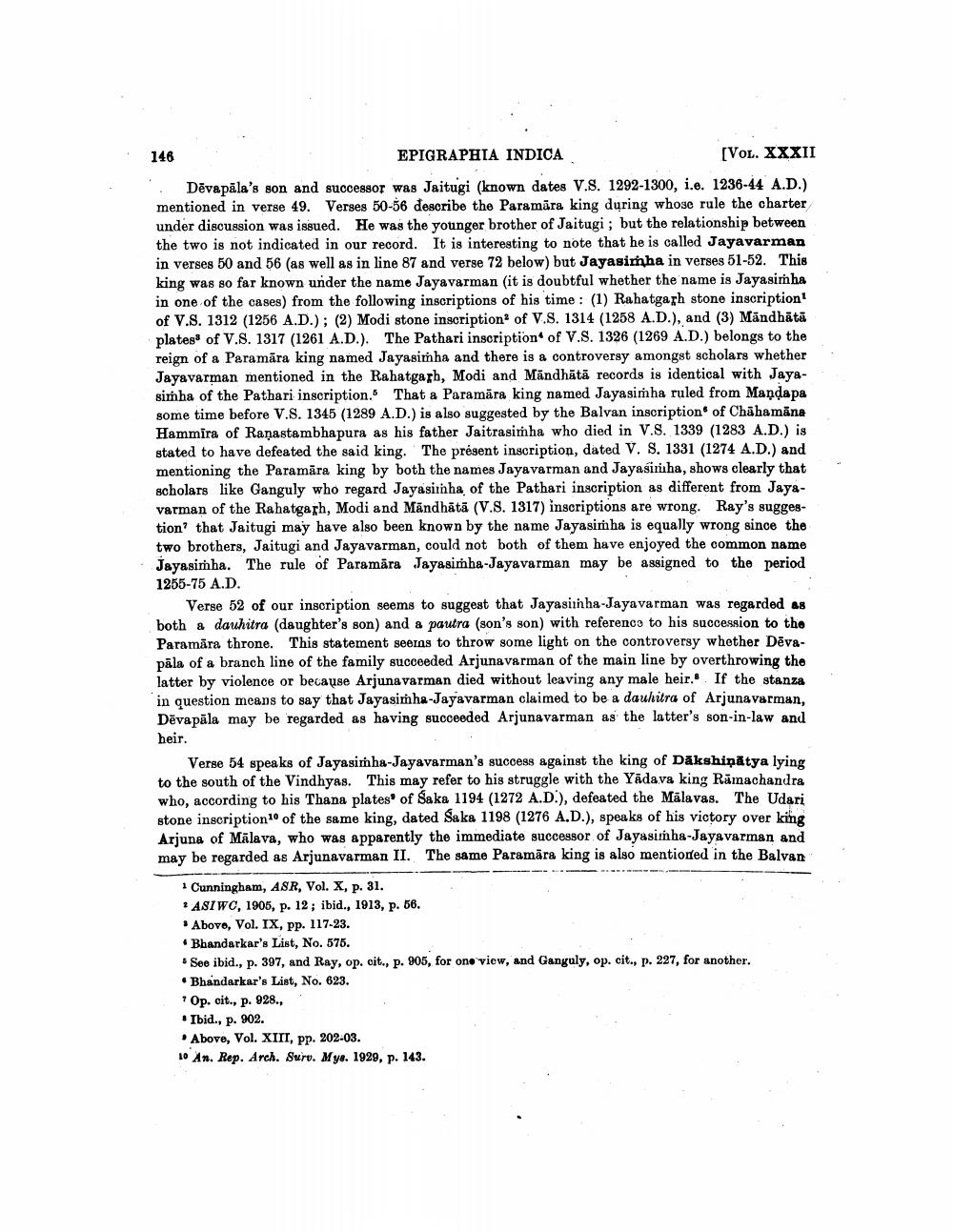________________
EPIGRAPHIA INDICA
[VOL. XXXII
Devapala's son and successor was Jaitugi (known dates V.S. 1292-1300, i.e. 1236-44 A.D.) mentioned in verse 49. Verses 50-56 describe the Paramāra king during whose rule the charter under discussion was issued. He was the younger brother of Jaitugi; but the relationship between the two is not indicated in our record. It is interesting to note that he is called Jayavarman in verses 50 and 56 (as well as in line 87 and verse 72 below) but Jayasimha in verses 51-52. This king was so far known under the name Jayavarman (it is doubtful whether the name is Jayasimha in one of the cases) from the following inscriptions of his time: (1) Rahatgarh stone inscription1 of V.S. 1312 (1256 A.D.); (2) Modi stone inscription of V.S. 1314 (1258 A.D.), and (3) Mändhätä plates of V.S. 1317 (1261 A.D.). The Pathari inscription of V.S. 1326 (1269 A.D.) belongs to the reign of a Paramāra king named Jayasimha and there is a controversy amongst scholars whether Jayavarman mentioned in the Rahatgarh, Modi and Mandhätä records is identical with Jayasimha of the Pathari inscription. That a Paramāra king named Jayasimha ruled from Mandapa some time before V.S. 1345 (1289 A.D.) is also suggested by the Balvan inscription of Chāhamana Hammira of Ranastambhapura as his father Jaitrasimha who died in V.S. 1339 (1283 A.D.) is stated to have defeated the said king. The présent inscription, dated V. S. 1331 (1274 A.D.) and mentioning the Paramāra king by both the names Jayavarman and Jayasimha, shows clearly that scholars like Ganguly who regard Jayasinha, of the Pathari inscription as different from Jayavarman of the Rahatgarh, Modi and Mandhātā (V.S. 1317) inscriptions are wrong. Ray's suggestion' that Jaitugi may have also been known by the name Jayasimha is equally wrong since the two brothers, Jaitugi and Jayavarman, could not both of them have enjoyed the common name Jayasimha. The rule of Paramara Jayasimha-Jayavarman may be assigned to the period
1255-75 A.D.
146
Verse 52 of our inscription seems to suggest that Jayasiinha-Jayavarman was regarded as both a dauhitra (daughter's son) and a pautra (son's son) with reference to his succession to the Paramāra throne. This statement seems to throw some light on the controversy whether Devapala of a branch line of the family succeeded Arjunavarman of the main line by overthrowing the latter by violence or because Arjunavarman died without leaving any male heir. If the stanza in question means to say that Jayasimha-Jayavarman claimed to be a dauhitra of Arjunavarman, Devapāla may be regarded as having succeeded Arjunavarman as the latter's son-in-law and heir.
Verse 54 speaks of Jayasimha-Jayavarman's success against the king of Dakshiņātya lying to the south of the Vindhyas. This may refer to his struggle with the Yadava king Ramachandra who, according to his Thana plates of Saka 1194 (1272 A.D.), defeated the Malavas. The Udari stone inscription10 of the same king, dated Saka 1198 (1276 A.D.), speaks of his victory over king Arjuna of Malava, who was apparently the immediate successor of Jayasimha-Jayavarman and may be regarded as Arjunavarman II. The same Paramāra king is also mentioned in the Balvan
1 Cunningham, ASR, Vol. X, p. 31.
2 ASIWC, 1905, p. 12; ibid., 1913, p. 56.
Above, Vol. IX, pp. 117-23.
Bhandarkar's List, No. 575.
See ibid., p. 397, and Ray, op. cit., p. 905, for one view, and Ganguly, op. cit., p. 227, for another. Bhandarkar's List, No. 623.
"Op. cit., p. 928.,
Ibid., p. 902.
Above, Vol. XIII, pp. 202-03.
10 An. Rep. Arch. Surv. Mys. 1929, p. 143.




